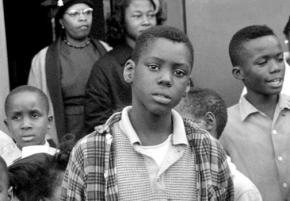Struggling against Jim Crow North
Chicago Public Schools parent reports on an inspirational commemoration of a 50-year-old struggle for the schools all our children deserve.
CLOSE TO 500 people gathered at Chicago's DuSable Museum of African American History to commemorate a barely known chapter in the struggle for civil rights in one of the country's most segregated city.
The event marked the 50th anniversary of the 1963 Chicago school boycott, when a quarter of a million predominantly African American residents, most of them students in the Chicago Public Schools (CPS), marched to protest segregated schools, inequality and the racist policies of CPS Superintendent Benjamin Willis.
The boycott was one of the largest political demonstrations in Chicago history and took place as the civil rights movement in the South had gained international attention. But almost no one, even in Chicago, remembers the struggle against Jim Crow North.
The commemoration at the end of October was inspirational. Among the panel of speakers were people involved in organizing the boycott 50 years ago. Also, a clip was shown from a documentary in progress about the civil rights struggle, titled '63 Boycott--Kartemquin Films says the full 30-minute documentary will be released soon.

The remarkable film is built around footage from the boycott, depicting African American students, alongside their parents, teachers and supporters, Black and white, marching with signs reading, "Improve our schools," "Give our children a chance" and "Jim Crow must go."
Other sections provide an up-close view of the grassroots nature of the struggle. In one scene from the day of the boycott, activists are packed into a room with a dozen phones on tables, all ringing at the same time and being answered by student, teacher and parent volunteers. The activists are taking down information as it comes in--another school to add to the list of those joining the boycott, another call to report how many children were in attendance at another school. This was the "boycott war room."
Then there are scenes from the mass march, with Black and white students streaming down the main streets of Chicago, marching along with parents, teachers and activists on their way to the Board of Education headquarters. All the marchers are ready to speak their mind into the microphones of journalists.
One student is asked why the boycotters are demanding updated textbooks--and explains eloquently that the new books explained in one page what the older books took eight pages to say. Needless to say, white schools had the updated textbooks.
ACCOMPANYING THE documentary was a panel of speakers to talk about the struggle for education justice, both then and now.
Rosie Simpson, a mother of six, was a leader in the education movement, along with Fannie Rushing, a member of the Student Nonviolent Coordinating Committee (SNCC) and a Freedom School teacher from 1962 to 1966. They spoke alongside Timuel Black, a retired teacher and well-known movement leader who was among the original organizers of the 1963 boycott.
These movement veterans were joined by historian Elizabeth Todd-Breland, who teaches history at the University of Illinois-Chicago, plus current-day activists Jason Perez of the Black Youth Project and Jitu Brown, an outspoken leader in education justice struggle and education organizer for the Kenwood Oakland Community Organization (KOCO). Malcolm London of Young Chicago Authors closed the night with one of his spoken word pieces.
The parallels between the fight waged in 1963 and the continued struggle for education justice were obvious throughout the night.
Asked how activists today could build a fightback on the scale of the 1963 struggle, Rosie Simpson answered that the focus has to be about building on the grassroots level by getting those most affected by the problem involved and participating. "The movement never comes from the top," Simpson reminded the audience. She also talked about how important it was to have small successes to energize participants.
Simpson explained that the struggle against segregation was really about access to resources. "We wanted our children to go to school with white children not so they would learn by osmosis, but so that they would have equality." Audience members recognized that we are fighting the same struggle today--for "The Schools Chicago's Students Deserve," as the Chicago Teachers Union put it in a report issued to explain the issues in their strike last year.
Anyone involved in the struggle today knows that class size is a major issue. The documentary depicted the outrageous conditions that gave rise to the boycott 50 years ago. Classrooms in schools in Black neighborhoods were so overcrowded that there was literally no room to teach children.
Rather than allow African American students to attend white schools, where their were plenty of empty seats, the racist Superintendent Benjamin Willis set up mobile trailers in school parking lots to create extra classroom space. These trailers became known as "Willis Wagons"--a term coined by Rosie Simpson--and were a focal point of the 1963 protests.
It would take until 1966 before Willis finally stepped down, and even longer before the 625 "Willis Wagon" classrooms were dismantled.
Jitu Brown talked about the education justice struggle today, but not before paying tribute to the veterans on the panel. "I'm humbled, and I'm hear to listen and to learn," he said. Brown went on to talk about some of the frustrations with the struggle today. He said activists need to press the call for an elected school board to bring some democracy into the process. "Until we get an elected school board in this city, no school is safe," he said.
The evening ended with many questions coming to the surface about how we should organize today to increase our number and combat the racism embedded in the structure of our schools?
While the experience of the 1963 boycott doesn't hold all the answers, it shows the possibility of mobilizing large numbers around a common cause and building mass pressure.


